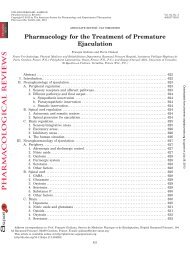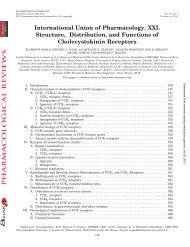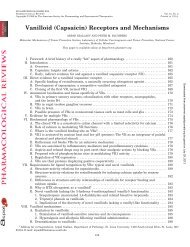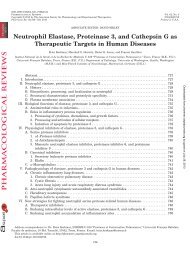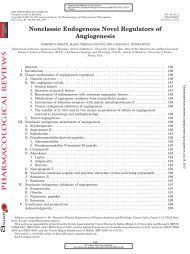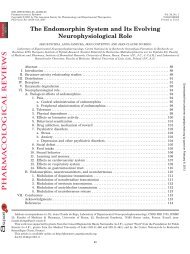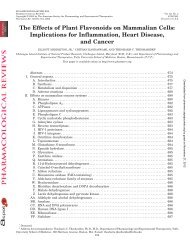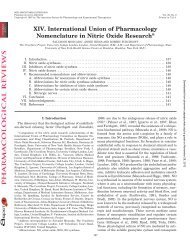Opioids, Reward and Addiction: An Encounter of Biology ...
Opioids, Reward and Addiction: An Encounter of Biology ...
Opioids, Reward and Addiction: An Encounter of Biology ...
You also want an ePaper? Increase the reach of your titles
YUMPU automatically turns print PDFs into web optimized ePapers that Google loves.
the drug with aversive effects will be lower than<br />
the number <strong>of</strong> placebo self-injections. To observe these<br />
aversive effects, however, relatively high levels <strong>of</strong> responding<br />
for placebo will be required, whereas in the<br />
place-conditioning method there is no such restriction.<br />
Second, the place-conditioning paradigm is not an operant<br />
task, but rather a classical (Pavlovian) conditioning<br />
paradigm. During conditioning, the drug will be delivered,<br />
irrespective <strong>of</strong> the behavior <strong>of</strong> the animal. What is<br />
learned is therefore not response conditioning but stimulus<br />
conditioning. However, what is measured during<br />
testing is not merely the result <strong>of</strong> classical conditioning<br />
because the approach behavior that is measured is not<br />
necessarily part <strong>of</strong> the primary (unconditioned) response<br />
<strong>of</strong> the animal to the drug. Third, the behavior <strong>of</strong> the<br />
animal is measured in the drug-free state. <strong>An</strong>y drug<br />
effects that might interfere with behavioral performance<br />
during testing is avoided. However, testing animals in a<br />
drug-free state is also a disadvantage. Since conditioning<br />
<strong>and</strong> testing are conducted in two different interoceptive<br />
states, state-dependent learning might occur, causing<br />
a risk <strong>of</strong> false negatives. Finally, since significant<br />
place-conditioning can be obtained with a small number<br />
<strong>of</strong> conditioning trials, the duration <strong>of</strong> the experiments is<br />
relatively short.<br />
The most serious disadvantage <strong>of</strong> the place-conditioning<br />
technique is that the interpretation <strong>of</strong> data is difficult. As<br />
most if not all substances that are self-administered by<br />
humans <strong>and</strong> laboratory animals also have the property to<br />
induce conditioned place preference, it is suggested that<br />
their positive affective properties play a significant role in<br />
the development <strong>of</strong> place preference. It is, however, hard to<br />
interpret what the animal is exactly expressing with its<br />
approach or avoidance behavior. The most likely explanation<br />
is that conditioned place preference reflects the desire<br />
to experience the effects <strong>of</strong> the drug. However, since in<br />
most cases only time spent in a certain compartment is<br />
scored, such a conclusion cannot definitely be drawn.<br />
III. Self-Administration<br />
A. Intravenous Opioid Self-Administration<br />
The first studies on i.v. opioid self-administration<br />
were performed in the 1960s. Different groups demonstrated<br />
that rhesus monkeys <strong>and</strong> rats would learn to<br />
press a lever to receive i.v. infusions with morphine<br />
(Weeks, 1962; Thompson <strong>and</strong> Schuster, 1964; Deneau et<br />
al., 1969). These experiments showed that morphine<br />
served as a positive reinforcer <strong>of</strong> self-administration behavior<br />
in animals made physically dependent on opioids<br />
as well as in animals which were naive to the drug<br />
(nondependent). These initial experiments have been<br />
replicated <strong>and</strong> extended by many laboratories over the<br />
last decades. Reviewing the studies evaluating the reinforcing<br />
properties <strong>of</strong> opioids in the self-administration<br />
paradigm revealed several procedures that could be classified<br />
under different headings. In the present overview,<br />
OPIOIDS, REWARD AND ADDICTION 349<br />
we divide them into the “acute” method <strong>and</strong> the “substitution”<br />
method.<br />
In the first method, the acute method, the animal is<br />
allowed access to the test drug without previous experience<br />
with this drug or any st<strong>and</strong>ard drug. Different procedures<br />
can be applied. For example, the animal is given initial<br />
access to vehicle (usually saline) for a few days to obtain<br />
control rates <strong>of</strong> responding before being <strong>of</strong>fered the test<br />
drug. Alternatively, the animal is initially trained to leverpress<br />
for a nondrug reinforcer (usually food pellets) on a<br />
continuous reinforcement schedule to familiarize the animal<br />
with lever-press responding. In a third procedure an<br />
animal without any previous experience with the behavioral<br />
requirements for the delivery <strong>of</strong> the drug is <strong>of</strong>fered<br />
access to the test drug. During the period <strong>of</strong> actual access<br />
each lever-press results in an infusion. The acute method<br />
is useful in assessing whether an animal will initiate selfadministration<br />
<strong>of</strong> the test compound, whether responding<br />
for the compound will change over time, <strong>and</strong> to assess<br />
dose-response curves <strong>of</strong> the test compound.<br />
In the substitution method, drug self-administration<br />
is first established with a st<strong>and</strong>ard compound known to<br />
be reinforcing. In short, during daily experimental sessions,<br />
animals are trained to respond for an i.v. delivery<br />
<strong>of</strong> a st<strong>and</strong>ard compound. This compound is referred to as<br />
baseline drug <strong>and</strong> is known to produce reliable selfadministration<br />
rates over sessions. In substitution studies<br />
evaluating the reinforcing properties <strong>of</strong> opioids, codeine,<br />
a pure opioid agonist, is mostly used as baseline<br />
drug, although some studies use cocaine as such. After<br />
responding becomes stable, a dose <strong>of</strong> a test compound or<br />
vehicle (usually saline) is substituted for the baseline<br />
drug for one or several sessions. If saline is substituted,<br />
responding tends to decline to relatively low rates (negative<br />
control). On the other h<strong>and</strong>, when a test compound<br />
is substituted, the compound may maintain responding<br />
at some level above that <strong>of</strong> saline. If this occurs, the drug<br />
is classified as a positive reinforcer. Using this method<br />
dose-response curves <strong>of</strong> test drugs can be generated <strong>and</strong><br />
relative reinforcement potencies <strong>of</strong> several drugs can be<br />
determined.<br />
The results <strong>of</strong> the opioid self-administration studies<br />
with these methods have been reviewed (e.g., Johanson<br />
<strong>and</strong> Balster, 1978; Griffiths <strong>and</strong> Balster, 1979; Woolverton<br />
<strong>and</strong> Schuster, 1983; Collins et al., 1984; Young et al.,<br />
1984; Balster <strong>and</strong> Lukas, 1985; Vaupel et al., 1986;<br />
Woods <strong>and</strong> Winger, 1987). In the next paragraphs, we<br />
summarize the early findings <strong>and</strong> refer to previous reviews<br />
for more detailed discussion.<br />
Johanson <strong>and</strong> Balster (1978) summarized data generated<br />
using the substitution method in monkeys to assess<br />
the reinforcing properties <strong>of</strong> several opioid drugs. They<br />
reported that, in general, all tested pure opioid agonists<br />
are readily self-administered under a variety <strong>of</strong> experimental<br />
protocols. These agonists include the opioid agonists<br />
l--acetylmethadol (LAAM), alfentanil, codeine, dihydroetorphine,<br />
etonitazine, etorphine, fentanyl, heroin,



